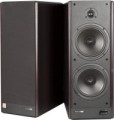Lines
The number of individual frequency bands played by the speaker. At least one specialized speaker is allocated for each such band.
The point of using multiple frequency bands is that for different frequencies, the optimal design of the speakers will also be different (for example, it is better to make tweeters small, and woofers large). Thus, dividing the sound into bands improves the sound. In turn, the advantage of
single-way speakers are compactness and lower cost.
Models for 2(LF / HF) or
3 bands(LF / MF / HF) are considered classic options for multi-band computer speakers. There are also
2.5 acoustics — it has 2 separate speakers for bass and treble plus a combined bass + midrange.
Signal-to-noise ratio
The ratio of the level of the useful signal (actually reproduced sound) to the level of extraneous noise provided by the speaker amplifier in normal mode.
Any amplifier inevitably creates its own noise; You can't get rid of them, but you can reduce their level. The higher the signal-to-noise ratio, the clearer the sound will be, the less noticeable extraneous interference will be. In modern computer speakers, this figure can vary from 52 – 55 dB (the minimum figure so that the noise does not cause much discomfort) to 90 – 95 dB (comparable to fairly advanced Hi-Fi equipment). However, note that the signal-to-noise ratio is far from the only parameter that affects the sound quality, and its high value does not guarantee a pleasant sound from the speakers.
Frequency range
The range of audio frequencies supported by acoustics. The wider this range — the fuller the reproduced sound, the lower the likelihood that some of these details at low or high frequencies will remain “behind the scenes”. At the same time, the human ear is able to hear frequencies of the order of 16 – 22,000 Hz, and with age, this range narrows even more. In modern audio equipment, especially at the top level, there may be more extensive ranges, but from a practical point of view, this does not make much sense. In addition, it is worth noting that a wide frequency range in itself does not guarantee high-quality sound — a lot also depends on the frequency response.
Impedance
The electrical resistance of the speakers to alternating current. This parameter is important primarily for normal compatibility with the amplifier: too low speaker impedance can lead to distortion, overload, and even damage to the speakers, and too high impedance can reduce the sound volume. At the same time, the vast majority of modern computer acoustics have their own amplifiers and are connected via a line input. Therefore, the impedance data is more of a reference value; in fact, this indicator may be needed only when connecting speakers to a “non-native” power amplifier, bypassing the standard one.
Detachable cable
The presence
of detachable cables will save you from possible damage to the device associated with bending the wires. If such an incident occurs, an easy replacement of the wire with a new one allows you to continue using the speakers, and not carry them to a service centre. However, this solution is mainly used in higher-level models, which affects the cost. At the same time, not only audio cables can be removable, for which connectors are provided (according to the classics, this is RCA), but also the power cable.

